FTC disclaimer: This post may contains affiliate links and we will be compensated if you click on a link and make a purchase.
Gallbladder cancer is not common, but early detection can lead to a cure. Yet, most cases are found when the cancer has spread, making treatment harder. This is because the gallbladder is deep inside the body, and symptoms may not show until it’s too late.
Being female, older than 65, having gallstones, or other gallbladder issues raises your risk.
Key Takeaways
- Gallbladder cancer is not a common type of cancer, but it can be cured if detected early.
- Most gallbladder cancers are found when they have already grown beyond the gallbladder, leading to a poorer prognosis.
- Gallbladder cancer may not present any symptoms until it has reached an advanced stage.
- Risk factors for gallbladder cancer include being female, increasing age, a history of gallstones, and other gallbladder conditions.
- Healthcare professionals have not yet found effective ways to prevent gallbladder cancer.
Understanding Gallbladder Cancer
What is Gallbladder Cancer?
Gallbladder cancer starts in the cells of the gallbladder, a small organ near the liver. It’s the most common cancer in the biliary tract, which includes the gallbladder and bile ducts. Most gallbladder cancers are adenocarcinoma, a cancer that starts in glandular cells.
Anatomy of the Gallbladder
The gallbladder is shaped like a pear and holds bile, a digestive fluid from the liver. Bile helps digest fats and is released into the small intestine. The gallbladder is under the liver and connects to it and the small intestine through ducts called the biliary tract.
Organ | Function |
|---|---|
Gallbladder | Stores and concentrates bile, a digestive fluid produced by the liver |
Liver | Produces bile to aid in the digestion of fats |
Biliary Tract | A network of ducts that connect the gallbladder and liver to the small intestine |
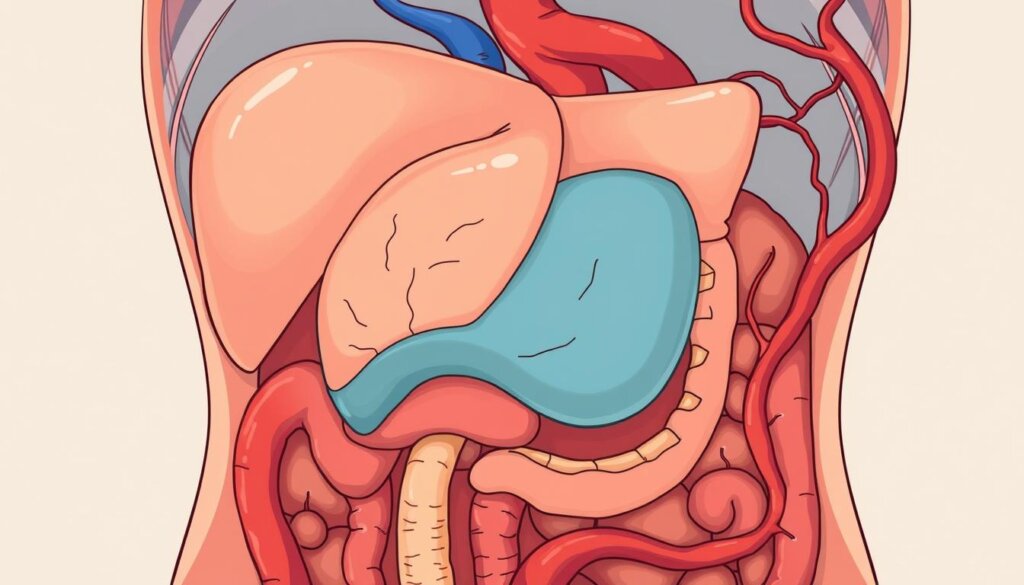
Knowing how the gallbladder works is key to understanding gallbladder cancer. Long-term inflammation is a big reason for gallbladder cancer.
Symptoms of Gallbladder Cancer
Early Signs and Symptoms
In the early stages, gallbladder cancer may not show any symptoms. But as it grows, symptoms start to appear. Common early signs include abdominal pain, belly bloating, and unexplained weight loss. Nausea and jaundice, as well as a yellowing of the skin and eyes, can also be early signs.
Advanced Symptoms
As gallbladder cancer gets worse, symptoms get more severe. You might feel more pain in your abdomen, back, or shoulder blades. You might also feel a mass on the right side of your abdomen.
Other signs include persistent nausea and vomiting, loss of appetite, and fatigue. If the cancer spreads, you might feel bone pain, shortness of breath, or have neurological issues.
Symptom | Early Stage | Advanced Stage |
|---|---|---|
Abdominal Pain | ✔ | ✔ |
Belly Bloating | ✔ | – |
Weight Loss | ✔ | ✔ |
Nausea | ✔ | ✔ |
Jaundice | ✔ | – |
Radiating Pain | – | ✔ |
Palpable Mass | – | ✔ |
Loss of Appetite | – | ✔ |
Fatigue | – | ✔ |
Itchy Skin | – | ✔ |
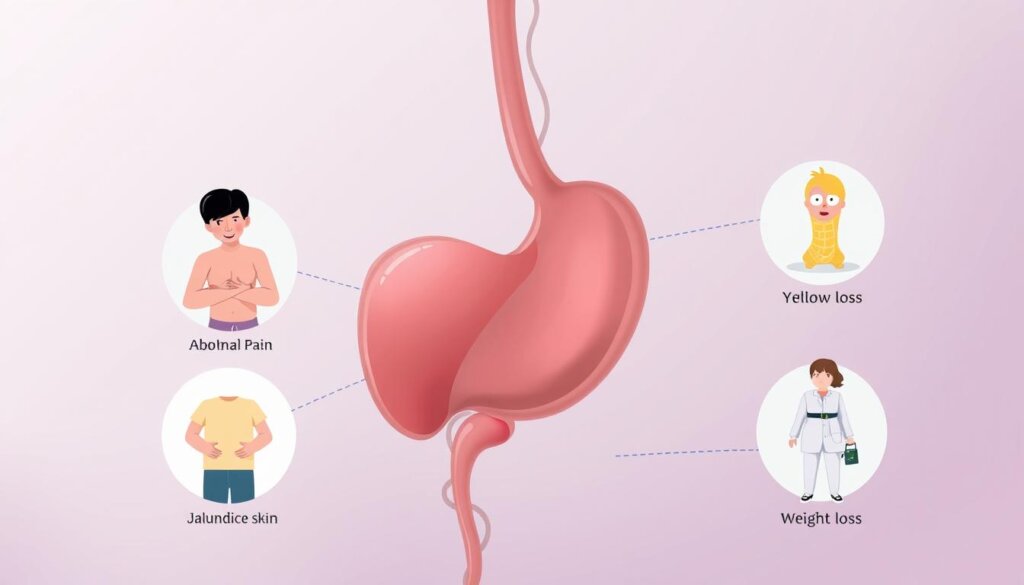
“Early stage cancers of the gallbladder are often incidental findings during surgeries conducted for other conditions like gallstones.”
Getting cancer treated early is key to success. This shows why seeing a doctor quickly is so important.
Causes and Risk Factors
The exact cause of gallbladder cancer is still a mystery. But, we know some things that can make it more likely to happen. Being female, older than 65, and having gallstones or chronic inflammation are big risk factors.
Gallstones are common, but gallbladder cancer is rare, even with gallstones. Yet, people with gallbladder issues are 5 times more likely to get cancer. Family history, certain medical conditions, and lifestyle choices also raise the risk.
Smoking, being overweight, and drinking too much alcohol can also increase your risk. The risk of gallbladder cancer varies worldwide. It’s higher in Latin America and Asia, but lower in the UK, USA, France, and Norway.
Risk Factor | Increased Risk |
|---|---|
Female sex | 71% of cases |
Gallbladder conditions (mainly gallstones) | 5 times higher risk |
Family history of gallbladder cancer | 5 times higher risk |
Primary sclerosing cholangitis | Slightly increased risk |
Smoking | Increased risk |
Obesity | Increased risk |
Alcohol consumption | Increased risk, especially heavy drinking |
Even though we don’t know everything about gallbladder cancer, we can still prevent and catch it early.
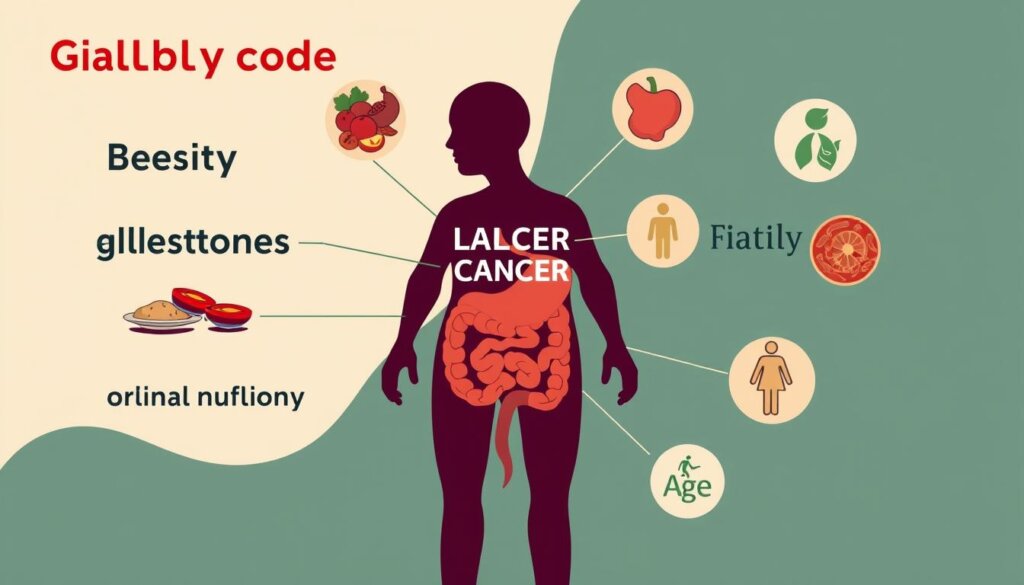
Gallbladder Cancer
Gallbladder cancer is a rare and aggressive cancer. It starts in the gallbladder, a small organ under the liver. It happens when healthy cells in the gallbladder change their DNA.
These DNA changes make the cells grow too fast and form a tumor. As the tumor grows, it can destroy healthy tissue. It can also spread to other parts of the body, a process called metastasis.
Gallbladder cancer often grows big before it’s found. This is because it may not show symptoms. It’s more common in certain areas.
Being overweight or obese can increase the risk of dying from gallbladder cancer. Genetic changes and certain infections can also cause it. Some factors, like alpha-methylacyl coenzyme A racemase overexpression, have been found in gallbladder cancer.
| Key Findings on Gallbladder Cancer |
|---|
| Cholangiocarcinoma is becoming more common in the United States. |
| Intrahepatic cholangiocarcinomas typically form in individuals with no known liver disease. |
| Hilar cholangiocarcinomas lead to jaundice and may require the removal of part of the liver. |
| Distal cholangiocarcinomas require complex surgeries such as the Whipple procedure. |
| Mount Sinai performs genomic sequencing on all cholangiocarcinoma patients. |
| Mount Sinai is one of the few centers in the United States offering liver transplantation for biliary cancers. |
| Chemotherapy and radiation are vital treatments for improving long-term survival rates in biliary cancer patients. |
| Only a few medical centers have the expertise to perform complex surgeries involving blood vessel and bile duct reconstruction for biliary cancers. |
Gallbladder cancer is hard to diagnose and treat. It often doesn’t show symptoms until it’s too late. But, new medical imaging and genomic sequencing are helping. Research and clinical trials are finding new ways to fight this cancer and help patients.
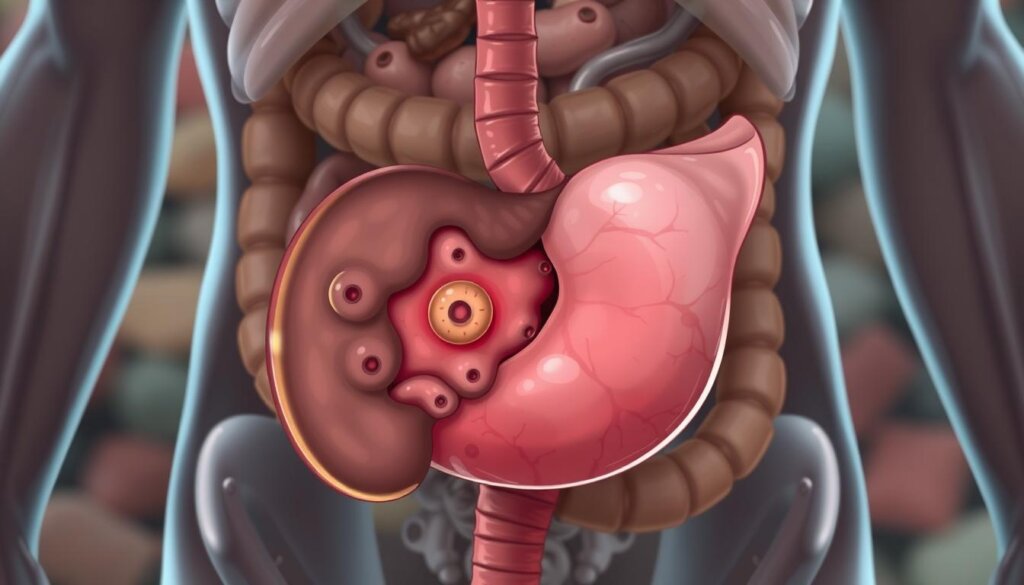
“Gallbladder cancer is a rare and aggressive form of cancer, but with early detection and appropriate treatment, we are seeing improvements in patient outcomes.”
Even though gallbladder cancer is rare, knowing the risks is important. If you notice any strange symptoms, see a doctor. Working with your healthcare team can help manage the disease and improve your health.
Diagnosis and Staging
To find gallbladder cancer, doctors use imaging tests like CT scans, MRI scans, or ultrasounds. These help to see the gallbladder and any other problems. A biopsy, where a small tumor sample is taken, might also be done. After finding the cancer, doctors check how far it has spread.
Diagnostic Tests
The TNM system is used to stage the cancer. It looks at the tumor size, spread, and if it’s in lymph nodes or has spread. Blood tests can also check for gallbladder, bile duct, or liver diseases. Tumor markers CEA and CA 19-9 might be high in advanced gallbladder cancer.
Ultrasound is often the first test for gallbladder cancer symptoms. CT scans help find out how far the cancer has spread. MRI scans give detailed images of soft tissues, helping tell if a tumor is cancerous.
Cholangiograms, like MRCP and ERCP, check the bile ducts for blockages. Angiography looks at blood vessels to see if cancer has affected blood flow. Laparoscopy is a small surgery to look at the gallbladder and nearby tissues.
Staging Gallbladder Cancer
The cancer stage is very important for treatment and survival chances. Gallbladder cancer makes up nearly half of all biliary tract cancers. The 5-year survival rate is less than 20%. About 5000 new cases were found in 2023.
Gallbladder adenocarcinoma is the most common type, often found by accident during surgery. Women are more likely to get it. Places with more gallstones and infections have higher rates of cancer, like Bolivia and Chile.
The cancer often has K-ras, TP53, CDKN2a, and c-erb-b2 mutations. It’s often linked to gallstones or polyps. Most are adenocarcinomas, with different cell types depending on the tumor.
Symptoms of gallbladder cancer can be similar to other gallbladder issues.
Treatment Options
The treatment for gallbladder cancer varies based on the disease stage and patient health. Early-stage cancers might need surgery to remove the gallbladder or a more detailed surgery called radical cholecystectomy. It’s important to see a surgeon with gallbladder cancer experience, as these surgeries are complex.
Surgery
Gallbladder cancers are split into two types: those that can be removed and those that can’t. For cancers that can be removed, surgery might include taking out parts of the liver and lymph nodes. Then, chemotherapy or radiation therapy might be used to help fight the cancer. If caught early, like T1a, the cancer might be removed completely in one surgery, and no more treatment is needed.
Chemotherapy and Radiation Therapy
For cancers that can’t be removed, treatments like immunotherapy and chemotherapy are used to control the cancer and ease symptoms. Palliative care is also key, helping manage symptoms and improve life quality for patients. For cancers that come back, treatments might include surgery for some cases or a mix of therapies for others.
Treating gallbladder cancer is a complex field with ongoing research and clinical trials. Groups like the National Comprehensive Cancer Network (NCCN) and the European Society for Medical Oncology (ESMO) offer guidelines for treating biliary tract cancers, including gallbladder cancer.
New treatments like targeted drugs and immunotherapy are showing promise in fighting gallbladder cancer. Studies like BILCAP and ABC-02 have given insights into treatment effectiveness and survival rates.
Every patient’s treatment plan for gallbladder cancer is unique, based on the disease stage, health, and latest medical advice. A team of doctors, including surgeons, gastroenterologists, and oncologists, works together to find the best treatment.
Managing Side Effects
Treatments for gallbladder cancer, like surgery and chemotherapy, can cause side effects. These include nausea, fatigue, pain, and digestive issues like diarrhea or constipation.
It’s important for patients to talk to their doctors about these side effects. They can get help through medicine, diet changes, and other care. Palliative care helps improve life quality by managing symptoms, not curing the cancer.
Common Side Effects
- Nausea and Vomiting: Anti-nausea meds and diet changes can help.
- Fatigue: Gentle exercise, rest, and nutrition can help manage it.
- Pain: Pain meds and other methods can offer relief.
- Digestive Issues: Diet changes, meds, and more fluids can help with diarrhea, constipation, and other problems.
Palliative treatments are used when cancer is too far gone for surgery. They include pain meds, anti-nausea drugs, and more to ease symptoms. Doctors choose these treatments because they have fewer side effects.
Patients can manage treatment side effects with their doctor’s help. This improves their life quality. Talking and acting early is crucial for the best results.
Prognosis and Survival Rates
The chance of surviving gallbladder cancer depends on when it’s found. If caught early, the 5-year survival rate can reach 69%. But, most cases are found too late, with a survival rate of just 3%. Finding it early is key to better treatment chances.
A study looked at 44 gallbladder cancer patients over 10 years. Those found before surgery lived about 4 months. Those found during surgery lived only 1 month. But, those found by chance after surgery or who got treatment lived up to 38 months.
Stage of Gallbladder Cancer | 5-Year Relative Survival Rate |
|---|---|
Localized | 69% |
Regional | 28% |
Distant Metastatic | 3% |
All Stages Combined | 20% |
These survival rates are for people diagnosed between 2012 and 2018. They come from the Surveillance, Epidemiology, and End Results (SEER) database.
In short, finding gallbladder cancer early is crucial. It can lead to a 69% 5-year survival rate. But, survival rates drop to 3% when cancer spreads. Patients found incidentally or through surgery have better chances.
Prevention and Early Detection
Gallbladder cancer is not very common. But it can be hard to find until it’s too late. There are ways to prevent it and find it early.
Keeping a healthy weight is key, as being overweight increases risk. Also, managing gallstones and chronic inflammation is important. Gallstones are common, but gallbladder cancer is rare, even with gallstones.
Regular health checks and screenings can help find problems early. But, screening for gallbladder cancer is not usually done because it’s hard to find early. Knowing the symptoms like pain and weight loss and seeing a doctor fast can help.
There’s no sure way to stop gallbladder cancer, but you can manage your health and watch for symptoms.
“The experts at Moffitt Cancer Center are actively exploring new screening methods to identify gallbladder cancer in its early stages for more effective treatment and potential cure of the disease.”
Living with Gallbladder Cancer
Coping and Support
Living with gallbladder cancer is tough. It affects both body and mind. Doctors might suggest check-ups every 6 months for 2 years after surgery. Staying active, eating right, and keeping a healthy weight can help.
Getting support from loved ones, groups, or counselors is key. Plans for living after cancer can guide you on health care and managing side effects.
No special foods have been shown to stop cancer from coming back. However, keeping health insurance is important for tests and visits. Side effects from treatment can last a long time, so ongoing support is vital.
“Emotional support from various sources such as friends, family, support groups, or professional counselors can greatly benefit individuals dealing with cancer.”
With the right support, living with gallbladder cancer gets easier. Talking to your doctor, making lifestyle changes, and using resources are important. They help you cope and aim for the best outcome.
Conclusion
Gallbladder cancer is rare but serious. It often goes unnoticed early on. Knowing the symptoms and risk factors and how to diagnose them is key to better outcomes.
Treatment options like surgery, chemotherapy, and radiation are available. But, the outlook is poor, especially if caught late.
Research and awareness about gallbladder cancer are vital. They help patients get diagnosed early and get the best care. Studies show early detection and accurate staging are crucial for better survival rates.
It’s important to stay alert about gallbladder cancer. This includes knowing its symptoms, risk factors, and diagnostic methods. Early detection and quick treatment are key to better chances of survival for this rare disease.
FAQ
What is gallbladder cancer?
Gallbladder cancer starts in the gallbladder, a small organ near the liver. It’s a type of cancer called adenocarcinoma. It grows in the glandular cells inside the gallbladder.
What are the symptoms of gallbladder cancer?
Early gallbladder cancer may not show symptoms. But when it does, you might feel pain in the upper right belly. You could also notice bloating, unexplained weight loss, and yellow skin and eyes (jaundice).
As it gets worse, you might feel a lump in your belly and keep feeling sick.
What are the risk factors for gallbladder cancer?
We don’t know the exact cause of gallbladder cancer. But, some things increase your risk. Being female and older (over 65) is a big risk. So are gallstones and other gallbladder problems.
Having a condition called primary sclerosing cholangitis also raises your risk.
How is gallbladder cancer diagnosed?
Doctors use tests like CT scans and ultrasounds to find gallbladder cancer. They might take a small sample of the tumor for a biopsy. This helps them know how far the cancer has spread.
What are the treatment options for gallbladder cancer?
Treatment depends on the cancer’s stage and your health. For early cancers, removing the gallbladder might be the main treatment. For more advanced cancers, surgery plus chemotherapy or radiation might be needed.
When the cancer has spread a lot, the focus is on making you comfortable.
What is the prognosis for gallbladder cancer?
The outlook depends on how early the cancer is found. If caught early, the 5-year survival rate is up to 50%. But, most cases are found when the cancer is advanced, leading to a survival rate of only 5-10%.
Finding it early is key to better treatment chances.
Can gallbladder cancer be prevented?
There’s no sure way to prevent gallbladder cancer. But, managing risk factors like gallstones and inflammation can help. Regular check-ups and screenings are important.
Knowing the early signs, like belly pain and weight loss, and seeing a doctor quickly can also help.
How can I cope with living with gallbladder cancer?
Living with gallbladder cancer is tough. It affects both body and mind. Getting emotional support and making lifestyle changes can help.
With the right care and support, many people can manage the challenges of gallbladder cancer.
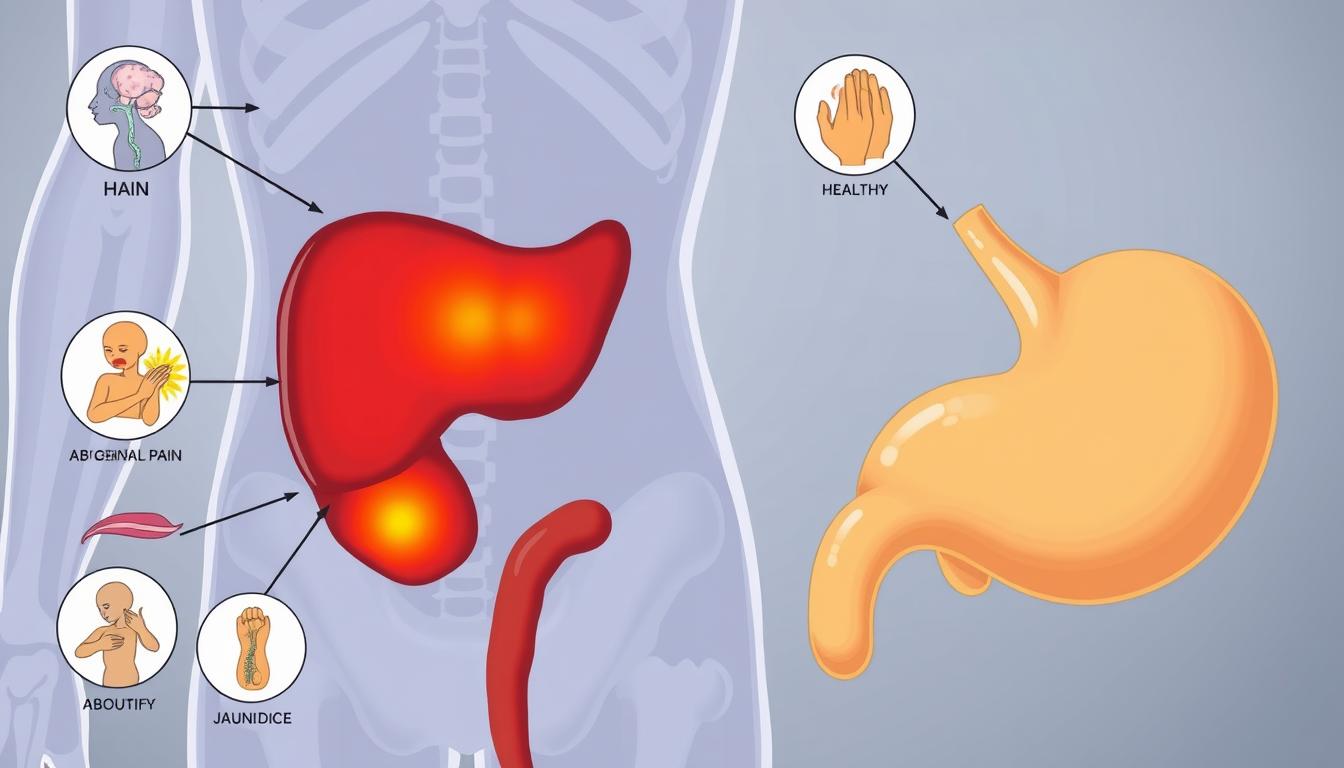

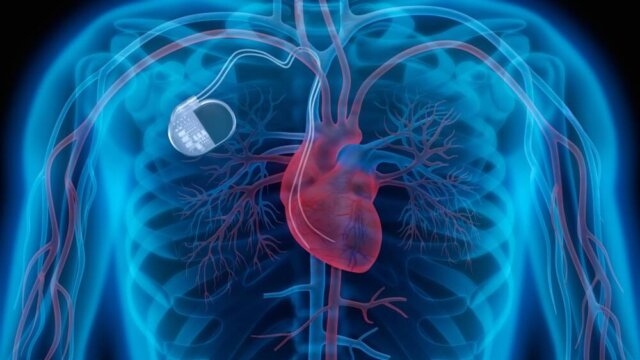
![8 Secrets of longevity: How to Live a Long and Happy Life [Definitive Guide]](https://healthyious.com/wp-content/uploads/2020/02/Secrets-of-longevity-how-to-live-long-life-640x360.jpg)




